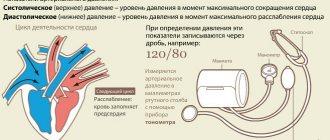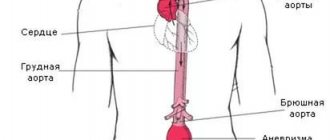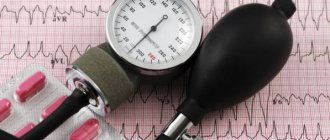Blood pressure is one of the main indicators of the functioning of the cardiovascular system. There are 4 types of it: intracardiac, capillary, venous and arterial.
Their parameters are assessed by measuring the last of the varieties using a tonometer. The resulting two numbers, for example, 130 per 90 mmHg, inform about the pressure in the arteries at the moment when the heart muscle contracts (systole) and during its relaxation phase (diastole). Blood diastolic pressure or DBP is a measure of peripheral vascular resistance.
Lower pressure depends on the tone of the walls of small arteries and heart rate
Since the value of DBP is reflected by the second digit of the indicator, it is popularly called lower, and systolic pressure - upper. Even in a healthy person, both indicators are not constant values.
They depend on the time of day, physical and psychological state, and ambient temperature. It is also important to have stimulating and/or medicinal substances in the blood that can either increase or decrease vascular tone, activate or inhibit myocardial function.
What is systole and diastole of the heart
Systole is the moment of maximum tension of the cardiac structures, contraction, release of blood into the aorta, then into the systemic circle and its movement throughout the body.
This is a key indicator in assessing the quality of the pumping function of a muscular organ, that is, its ability to perform the main task: to ensure continuous flow of liquid tissue, trophism (nutrition) of all systems.
Accordingly, systolic is the upper pressure, which is written in medical documentation and literature up to the slash (for example, 130/80, systolic indicator - 130).
Diastole is the moment of maximum relaxation of a muscle organ. The heart rests between beats to allow normal contractility.
The level of corresponding blood pressure indicates the ability for repolarization, spontaneous autonomous restoration of cardiac activity.
Diastolic is the lower pressure, respectively, the criterion for assessing in a closed system at rest, for a few fractions of seconds.
- When the level increases, we can talk about insufficient quality of rest for the heart. This means that the tissues will wear out faster and the resource of the muscle structure will be exhausted earlier.
- A decrease in diastolic pressure indicates cardiac dysfunction. What kind - we need to find out. We are not always talking about insufficiency; weakness of the sinus node is possible.
Thus, systole and diastole are cardiological terms that reflect objective processes: contraction of the heart and ejection of blood into the systemic circle, and relaxation to maintain normal activity, respectively.
Both values are measured in mmHg. Formally, we are talking about the difference between the indicator in the bloodstream and the atmospheric level outside the human body as a separate closed system.
The practical value of the described levels is revealed during diagnostics.
What is lower pressure responsible for?
Diastolic pressure means how much resistance the blood circulates through the vessels. It is responsible for the tone and ability of superficial vessels to respond to any changes. If the indicators are high for a long time, then there is a risk of serious consequences. If the indicator is low, the process of supplying internal organs with oxygen and nutritional components is disrupted.
Diastolic pressure parameters depend not only on the elasticity of blood vessels, but also on the functioning of the kidneys. Any disorders of the urinary system negatively affect measurement performance.
If both indicators are reduced at the same time, then this condition can be caused by anemia, dehydration, tuberculosis, atherosclerosis, stress, and problems with the endocrine system.
If the lower result deviates from the norm, the patient's condition worsens. There is increased fatigue, weakness, irritability, decreased vision, nausea, and pain of varying intensity in any area of the head.
The concept of pulse pressure
Some points are present only as a theoretical phenomenon. They do not exist in reality and cannot be measured by objective methods without third-party actions by the doctor. What is it?
As already mentioned, systolic pressure is the upper one. It shows how hard the heart contracts, how well it pumps blood, and can also indirectly be used to assess the risk of heart attack or stroke.
Diastolic pressure is the lower one, indicating values in line with when the heart is relaxed and not beating (for an extremely short period of time). It also speaks about the quality of rest of the muscle organ.
Used to determine the likelihood of emergency conditions and prognosis. What is pulse pressure? This is the difference between systolic and diastolic readings.
Pulse pressure (abbreviated as PP) is one of the key values in identifying the state of the cardiovascular system.
Clinical recommendations used by cardiologists provide a lot of information on deciphering pulse pressure:
- To put it simply, a high level of PP is characteristic of a significant risk of heart attack or stroke.
- Low rather means dysfunctional phenomena, defects, heart failure, which cannot be called an axiom. There are always exceptions.
There are many options for this. The same pulse pressure can be with different variations of the upper and lower values.
For example, isolated hypotension, low systolic pressure with normal diastolic pressure.
Therefore, not only the PD, but also the features of the two previous fundamental levels are subject to assessment.
Read more about PD standards for women and men and possible deviations in this article.
Blood pressure: what is it
Blood pressure indicates the degree of influence of circulating blood on the inner walls of blood vessels. It allows you to assess the condition of not only the circulatory system, but also cardiovascular activity.
Pressure readings are affected by the force with which the heart contracts and the resistance that the blood receives during movement. Another decisive factor is the volume of blood ejected at the moment of heart contraction.
At the moment of blood leaving the left ventricle, the highest measurement result is noted.
The lowest result is observed during the period of blood entering the right atrium, when the heart muscle is in a relaxed state.
What influences the indicators
The factors regulating blood pressure are diverse and are not always obvious during diagnosis.
Knowledge of the complete list and mechanisms for changing levels allows you to reduce the time for examination.
- Hormonal background. With dysfunction, a violation of the concentration of active substances, incorrect and inadequate regulation of vascular tone occurs, and through it, cardiac activity.
A role is played by compounds produced by the thyroid gland, adrenal cortex, pituitary gland, and sex-specific substances.
The key importance is given to angiotensin-II, aldosterone, cortisol, norepinephrine and renin.
They are produced by different structures, but they always act according to the same pattern: they provoke stenosis, narrowing of the arteries due to excessive discharge, vascular weakness, and their low tone against the background of deficiency.
The reasons for the development of such disorders are also different; the problem is interdisciplinary.
- The work of the autonomic nervous system. It is autonomous and not controlled by a person at a conscious level. It has an extremely complex and intricate regulatory system; its functioning is responsible, among other things, for the adaptation of heart rate and blood pressure.
- The work of the central nervous system. When the cerebral hemispheres or brain stem are damaged, catastrophic consequences develop.
Because cardiac activity as such is determined by the constant receipt of signals from the brain. This is a key limitation on the autonomy of the muscular organ.
- Individual characteristics of the physiology of a particular patient. They consist of a unique “set” of characteristics: gender, age, somatic and mental illnesses, family history, heredity and genetic factors, characteristics of reactions to environmental stimuli.
These are the four main regulatory mechanisms. They can be detailed on specific properties:
- Contractility of the heart. Shows how well the body can withstand the cardiac cycle, the change of systole and diastole. If the pumping function is disrupted, the upper and lower pressure drops. The pulse may remain normal or be low compared to the reference range.
- The amount of blood circulating in the body. If there is a deficiency (for example, after an injury with hemorrhage), a drop in blood pressure is observed. Excess is also common (a common variant is due to kidney pathologies and fluid retention), it is accompanied by an increase in tonometer readings.
- Vascular tone. Spasm or relaxation. To what extent is this or that observed, how closed the lumen is, what diameter of the tubular structures are affected. These data are being updated. With an increase in tone, an increase in blood pressure is detected. If it goes down, it means a fall.
- The condition of the aorta and heart valves, responsible for transporting fluid tissue into the systemic circle. In case of insufficiency, congenital or acquired defects (for example, mitral valve stenosis), and other diseases, an isolated increase in diastolic pressure is detected. The risks of emergency conditions increase 2-3 times and increase as the disorder progresses.
- The volume of blood released into the large circle. It is determined by the first criterion mentioned above. With a small amount, low blood pressure is detected. And vice versa.
All of these points are assessed in a comprehensive manner. Some phenomena can only be guessed at; routine methods cannot clarify the situation; diagnostics are required for an accurate determination.
Reduced diastolic pressure
Various reasons can reduce diastolic pressure, but there are the most pronounced factors of influence. If they are eliminated in a timely manner, they can have a positive impact on health.
Diastolic pressure is less than 60 mm Hg. indicates the presence of diastolic hypotension.
- Drugs are a common cause of decreased diastolic blood pressure. There are some drugs that help lower diastolic blood pressure more than systolic blood pressure. In particular, a class of medications called alpha-blockers or central-acting antihypertensives are most likely to cause a decrease in diastolic blood pressure.
- Allergic reactions , especially severe reactions known as anaphylaxis, can cause hypotension. Typically, diastolic and systolic blood pressure decreases. Anaphylaxis is a life-threatening condition that usually includes other symptoms such as difficulty breathing, itching, redness of the skin, hives, and a swollen face or throat. Red skin is caused by dilation of blood vessels under the surface of the skin. This expansion causes less pressure on the artery walls, causing a drop in blood pressure.
- Septicemia. A serious infection in the bloodstream, known as septicemia, can also cause low blood pressure. Sepsis is often accompanied by fever and generalized redness of the skin, which can impair the function of body organs such as the heart, lungs and kidneys. Very low blood pressure caused by septicemia is called septic shock, and the condition is life-threatening.
- Endocrine disorders . Inadequate synthesis of hormones by the endocrine glands can lead to diastolic hypotension, which is often accompanied by systolic hypotension. Such disorders are mainly associated with thyroid insufficiency (hypothyroidism), dysfunction of the parathyroid glands (hypoparathyroidism), adrenal dysfunction, and Addison's disease. Hypotension is also a common sign of low blood sugar (hypoglycemia). Some people with diabetes develop hypotension even without hypoglycemia. This may be due to diabetes, causing damage to the nerves that help maintain normal blood pressure.
- Cardiac disorders . When the heart is unable to pump normal amounts of blood to all parts of the body, blood pressure drops. A heart rate that is too low or too high can contribute to the development of hypotension. Abnormal heart rhythms such as atrial fibrillation can also cause hypotension. Low diastolic pressure often occurs with heart valve disease, myocardial infarction, or heart failure. When aortic regurgitation occurs, diastolic pressure decreases, but systolic pressure usually remains normal.
- Pulmonary embolism . A blood clot that blocks blood circulation in the vessels of the lungs causes a pulmonary embolism. This may lower blood pressure, especially if thrombosis is severe. This happens because blood from the right side of the heart cannot reach the left side, from where it spreads throughout the body.
Other causes of diastolic hypotension can be either high or low body temperature. In such cases, hypotension occurs through temperature effects on heart rhythm, the heart's ability to pump blood, or the width of the lumen of blood vessels.
Severe liver disease also tends to enlarge blood vessels in the body, lowering diastolic blood pressure. Prolonged bed rest often leads to diastolic hypotension.
Due to many neurological conditions, diastolic pressure decreases. This is usually due to disruption of the body's normal nerve reflexes that help keep blood pressure within normal limits. Spinal cord or head injuries, strokes, Parkinson's disease, and multiple sclerosis are examples of neurological conditions that can cause a decrease in blood pressure, including diastolic pressure.
The main symptoms of low diastolic pressure:
- Dizziness.
- Nausea.
- Fainting.
- Dehydration and unusual thirst.
- Lack of concentration.
- Blurred vision.
- Cold, clammy, pale skin.
- Fast, frequent breathing.
- Fatigue.
- Depression.
Normal indicators by age
Approximate ranges are presented in the table:
| Age | Minimum possible blood pressure (syst./diast.) | Maximum level (identical) |
| 1 – 30 days of life | 60/40 | 75/50 |
| Up to 1 year | 80/50 | 85/55 |
| 1-5 years | 85/50 | 100/58 |
| 6-12 | 95/60 | 110/62 |
| 12-15 | 100/62 | 120/80 |
| 15-20 | 110/75 | 125/82 |
| 20-40 | 115/80 | 130/85 |
| 40-50 | 120/80 | 132/87 |
| 50-60 | 120/82 | 138/88 |
| 60-70 | 125/85 | 140/84 |
| 70-80 | 125/85 | 142/85 |
| Over 80 | 123/83 | 140/83 |
Adequate and reference values are approximate. That is why they are presented in a range.
Detailed values divided into women and men are presented in this article.
The level of normal blood pressure in a particular patient is influenced by many factors.
Just a few are worth mentioning:
- Age. As you grow and then age, the tonometer readings steadily increase. This is a clinically acceptable option, provided that the numbers are within the range generally accepted by cardiologists.
- Floor. In women, blood pressure is initially higher. Only in the early years, in childhood, the level is lower than in boys. Among representatives of much of humanity, the numbers are higher by approximately 3-5 mmHg.
- Hormonal background. This refers to a normal level, a combination of specific substances. May change during peak periods: adulthood and puberty (puberty), menstrual cycle, pregnancy, menopause in women and andropause in men (menopause).
- Family history. Heredity and genetic factor. If there are patients with hypertension and other conditions in the family, the probability of deviation is almost twice as high or even more.
- Features of professional activity. Athletes have lower blood pressure and heart rate than the average person.
- Body mass. The connection is not obvious, many doctors make the same mistake. The problem is not so much the weight, but the deviations behind it.
Usually this is an incorrect exchange of lipid structures in the body. When fats are deposited (deposited) in excess quantities, compounds also enter the bloodstream (the notorious cholesterol).
They are deposited on the walls of blood vessels, form plaques, and narrow the lumen of hollow structures. Hence the deterioration of circulation and an increase in blood pressure.
- Metabolic processes, their speed.
- The presence of stress in life, the frequency of such.
And many other factors.
At what numbers should you consult a doctor and what needs to be examined?
As already mentioned, blood pressure is a purely individual indicator. But in order to say something specific, you need to conduct a thorough diagnosis.
The reason for going to the doctor is a deviation of the tonometer reading from the described generally accepted conditional norm by 10 mm Hg. Art. and more. An increase or decrease in numbers does not always necessarily indicate illness. Variations are possible.
The list of measures is variable and depends on specific hypotheses that are subject to refutation (list of probable diseases).
- Oral questioning of the patient regarding complaints. Also taking anamnesis. To determine the possible vector of further work with the patient.
- Blood pressure measurement. On both hands with an interval of 5-10 minutes to obtain an accurate result.
- 24-hour Holter monitoring. Allows you to evaluate blood pressure and heart rate to more accurately identify the state of cardiac structures over time. The patient is in familiar conditions, which is ideal for diagnostic purposes. Any deviations are assessed as potentially pathogenic.
- Electrocardiography. It is carried out using a special device that accurately records the heart rhythm and shows all functional deviations. The problem is the need to take into account a lot of nuances when decoding and high requirements for the qualifications of specialists. With sufficient professionalism and attentiveness, the doctor receives an informative result.
- Echocardiography. Ultrasound technique for visualizing cardiac tissues. Helps identify defects, anatomical defects of the muscular organ and large vessels (parts of the aorta, pulmonary artery). Used along with ECG for early assessment. Considered the gold standard for diagnosis.
- MRI of the heart. Prescribed in complex and controversial clinical situations. Allows you to obtain detailed images. If necessary, a contrast agent is used for spot visualization.
- Blood test for hormones. Also general research. Biochemistry.
If necessary - angio-, coronography and other methods. Changes in blood pressure are an interdisciplinary problem. Therefore, the efforts of one cardiologist are not always enough.
Preventive measures to maintain normal levels
- Full sleep. For children it should be 8-9 hours per day. Deviations towards reduction are strictly unacceptable. This is dangerous for both blood vessels and the heart. It also has a negative effect on the psyche. Adults should definitely get at least 7 hours of rest at night. Moreover, the ideal option is for a third of the time to fall before 23.00.
- Quality food. Less animal fats, more plant foods. Salt up to 7 grams in laziness, more is not allowed, complete refusal is unacceptable, because it is likely that the heart will be affected. Fried foods, smoked foods, canned food, and semi-finished products are also excluded. Quitting bad habits. Smoking, consumption of alcohol, drugs.
- Adequate physical activity. At a level acceptable for a particular patient. Hiking in the fresh air, swimming, cycling at a minimum amateur level are ideal. Jogging is acceptable, but it leads to an increase in blood pressure, so you need to carefully monitor your well-being. It is better to first consult with a cardiologist or exercise therapy specialist and clarify the nature of the recommended activity.
- Timely treatment of all somatic and mental disorders.
- Regular visits to a cardiologist and other specialists as necessary. To undergo examinations and prevent diseases. Such complications.
- Avoiding stress. It is impossible to completely hide from psycho-emotional stress in the modern world. But you need to try to minimize situations. Also increase resistance to such influences. For example, it is recommended to master relaxation techniques. If necessary, you should contact a psychotherapist to receive qualified help.
- If necessary, review the scope of professional activity. The task can be difficult. But in some cases it is a matter of maintaining health.
- Compliance with all recommendations of the treating specialist. If a doctor at a consultation appointment, after a thorough assessment of a person’s condition, gives any advice on prevention, it makes sense to listen.
Specific preventive measures are not difficult, but require a strong-willed effort to change lifestyle. The process will become easier if you have motivation, including additional motivation.











